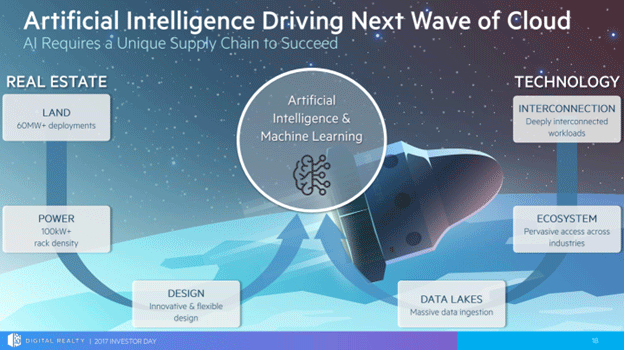Hear from TLA sponsor Digital Realty about the power of AI.
We Built the Infrastructure You Need to Power AI Innovation.
It may seem like artificial intelligence (AI) became a media buzzword overnight, but this disruptive technology has been at the forefront of our agenda for several years at Digital Realty. We’ve seen how the advent of cloud technology significantly transformed the landscape of digital business, and AI is set to disrupt industries in ways we are only beginning to understand. The key, as always, is to be on the right side of disruption, by embracing change and leveraging it to your advantage.
Getting AI right is a race to the finish line: enterprises are feeling the pressure to harness AI to build unique value ahead of their competitors.
Digital Realty anticipated how AI would disrupt IT infrastructure and began planning a roadmap to support our customers over six years ago, working with groundbreaking early adopters and learning along the way. Here’s what we’ve learned is necessary to successfully navigate the inevitable disruption and come out ahead by harnessing AI’s potential.
AI’s Evolution: Machine Learning, Deep Learning, Generative AI
AI encompasses a suite of rapidly evolving technologies. It’s a journey that started in earnest during the early 2000s with machine learning (ML). ML crunches vast amounts of data to “learn” from results, discover patterns, make predictions, and even automate some tasks.
Then came deep learning in the 2010s, further enhancing perception capabilities in computer vision. This enabled object classification and detection, voice recognition, and even partly autonomous vehicles.
Now, we are witnessing the rise of generative AI in the 2020s, which emphasizes language mastery. Its implications are profound, given how language permeates every facet of an organization’s activities – institutional knowledge, communication, and processes.
The potential benefits are enormous: Accenture estimates that 40% of all working hours can be augmented by large language models like GPT-4 and 65% of language tasks can be transformed into more productive activities through augmentation and automation.
Crucially, all these AI technologies hinge on data. That’s why our focus at Digital Realty has always been about data, and managing Data Gravity challenges, to help ensure our customers can efficiently store, analyze, and extract value from their data by providing the meeting place where companies, technologies and data come together.
Cloud as a Case Study: What We Learned
The cloud journey is a good case study for thinking about disruption. I remember its inception and the initial debates about whether the cloud was friend or foe, and many enterprises are still navigating through its profound impact on digital transformation.
Your data oceans feed your cloud workloads and applications, which then creates even more data. The big question now is how do you optimize this relationship to create maximum value?
Initially, cloud was accessed over the public internet, often with little thought to proximity and security. Many enterprises are understanding that in practice, proximity and security matter immensely and businesses can lose their competitive edge if they don’t optimize each. In fact, I’ve built my career on pioneering private cloud consumption and enabling businesses to optimize their digital transformations.
Digital Realty has been instrumental in transforming the cloud into a safe and efficient environment where businesses can drive unique value.Today, we manage over 2.4 GW (gigawatts) of power and enable connected campuses across the globe.¹ We’re working to lower barriers to optimize hybrid multi-cloud with ServiceFabric™ Connect, a private, software-defined interconnection solution.
Having assisted many of our 5,000 customers in their cloud journey, we’re poised to do the same for your AI journey.
Unlock the Value from Your Data with AI
Falling behind in AI could mean getting disrupted. It’s a land rush to build unique value over competitors and to fend off new entrants like digital disruptors that aren’t contending with legacy infrastructure.
Here at Digital Realty, we’ve been tracking the evolution of AI since before our Investor Day in 2017, where we identified AI as a primary driver of next-generation data center requirements. Digital Realty has been aligning our offerings to meet these emerging demands. We understood that our customers would need an AI-ready global data center platform purpose-built to deploy and scale innovation and drive business value.

Source: Digital Realty Investor Day presentation, Slide 18, 2017
Why Does AI Require an AI-Ready Data Center Platform?
AI, especially analytics, requires a specialized environment due to specific hardware and data processing requirements. Power density requirements for AI can be 5-10x more than traditional data center functions, and the need for liquid cooling is fast approaching.
Digital Realty’s solution? A range of state-of-the-art tools to build optimized AI architectures and the ability to digitally engineer deployments in virtual environments. Digital Realty’s data center designs contain modularity and large capacity blocks to support legacy and high-density AI deployments, all interconnected with ServiceFabric™, a global, purpose-built network fabric.
We’re also committed to sustained and sustainable growth. We can support your sustainable data needs of today and tomorrow with 400 MW of space expected to come online in the next 18 months, 1 GW of renewable energy under contract, and our entire European portfolio and our US colocation portfolio are 100% renewable powered.
Digital Realty has supported the cloud providers globally for years and we developed core competencies along the way that enable us to do the same for our customers who need a home for AI.
Stay innovative, reach out to us, and let’s deploy AI in a way that transforms your organization.
This is part 1 of a 3-part series about AI-Ready Data Center Infrastructure. Stay tuned for what’s next:
Part 2: Data Center Obsolescence? Not on our watch.
Part 3: Integrating AI with Legacy Infrastructure
¹As of March 31, 2023 and represents consolidated portfolio plus our managed portfolio of unconsolidated joint ventures based on our ownership percentage.


